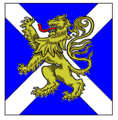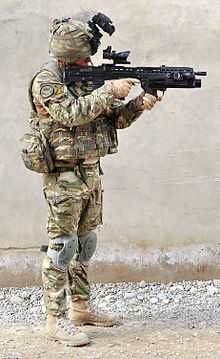Royal Highland Fusiliers
| Royal Highland Fusiliers, 2nd Battalion The Royal Regiment of Scotland | |
|---|---|
| Active | 28 March 2006- |
| Allegiance |
|
| Branch |
|
| Type | Line Infantry |
| Part of | 52 Brigaderole=Light Role Infantry |
| Garrison/HQ | Glencorse Barracks, Penicuik |
| Motto | Nemo Me Impune Lacessit (No One Assails Me With Impunity) |
| March |
Pipes, Drums and Bugles: Quick Marches - Hielan' Laddie/Blue Bonnets over The Border Slow March - My Home Military Band: Quick Marches - Whistle o'er the Lave o't/The British Grenadiers Slow Marches - The Garb of Auld Gaul/The March of the 21st Regiment. |
| Anniversaries | Assaye (23 September) |
| Commanders | |
| Royal Colonel | HRH The Duke of York |
| Insignia | |
| Tactical Recognition Flash |
 |
| Tartan |
Government Red Erskine (Pipers kilts and plaids) |
| Hackle |
White From Royal Scots Fusiliers |
| Royal Highland Fusiliers | |
|---|---|
|
Former Royal Highland Fusiliers Cap Badge and Mackenzie tartan, now only worn by the Drum major | |
| Active | 20 January 1959-28 March 2006 |
| Country | United Kingdom |
| Branch | Army |
| Type | Line Infantry |
| Role | Light Role Infantry |
| Size | One battalion |
| Part of | 1st Mechanised Brigade |
| Garrison/HQ | Glencorse Barracks, Penicuik |
| Motto | Nemo Me Impune Lacessit (No One Assails Me With Impunity) |
| March | Whistle o'er the Lave o't/The British Grenadiers |
| Anniversaries | Assaye (23 September) |
| Commanders | |
| Royal Colonel | HRH The Duke of York |
| Insignia | |
| Tartan |
Government Red Erskine (Pipers kilts and plaids) |
| Hackle |
White From Royal Scots Fusiliers |
The Royal Highland Fusiliers, 2nd Battalion, The Royal Regiment of Scotland (2 SCOTS) is an infantry battalion of the Royal Regiment of Scotland.
History
The regiment was formed on 20 January 1959 by the then amalgamation of the Royal Scots Fusiliers with the Highland Light Infantry (City of Glasgow Regiment). The Royal Highland Fusiliers remained an infantry regiment in its own right; the Royal Highland Fusiliers (Princess Margaret's Own Glasgow and Ayrshire Regiment) was part of the Scottish Division, and abbreviated as 'The RHF'.[1]
The regiment was initially based at Redford Barracks in Edinburgh and was deployed to Aden in 1960. 1961/62 it was stationed in Malta.It moved to Mons Barracks in Iserlohn in 1963 and to Fort George in 1967. 1965/66 the Regiment was deployed to Cyprus on Unficyp duties for six (6 months) In 1968 the Regiment was deployed to Gibraltar on frontier duties as the Spanish had closed the frontier.[1] The regiment undertook five tours in Northern Ireland during the Troubles in the 1970s. It relocated to Kiwi Barracks at Bulford Camp in 1970, returned to Redford Barracks in 1973 and moved on to Barrosa Barracks at Hemer in 1979.[1]
The regiment moved to Palace Barracks at Holywood in 1983, went on to Berlin in 1985 and returned to Redford Barracks before going to Oakington Barracks at Cambridge in 1989.[1] After taking part in the Gulf War in 1991, the regiment moved to St Barbara Barracks at Fallingbostel in 1993 from where it deployed units to Bosnia in 1994 and to Macedonia and Kosovo in 1999.[1]
The regiment moved back to Fort George in 2000 and to Salamanca Barracks in Cyprus from where it sent units to Iraq for Operation Telic in 2003.[1] As part of the Delivering Security in a Changing World Review of the Armed Forces, the regiment was amalgamated with the other regiments of the Scottish Division to become the 2nd Battaion of the Royal Regiment of Scotland which was formed on 28 March 2006.[1]
Currently as a light role battalionThe Regimment also under the command of 1st Mechanized Brigade (United Kingdom), the battalion also has responsibility for public duties in Edinburgh. The battalion is based at Glencorse Barracks in Penicuik.[2]
Regimental heritage
The regiment and current battalion has the distinction among British infantry regiments of carrying three Colours on parade. In addition to the Queen's and Regimental Colours, the third - the Assaye Colour, was originally awarded by the Governor General in Council in India on behalf of the British East India Company to the 74th Highland Regiment for distinguished service at the Battle of Assaye in India in 1803 while under the command of Sir Arthur Wellesley, the future Duke of Wellington.[3]
The Regiment maintained the traditions of the long 'Attention' command being given on parade (rather than the modern abbreviated Army 'shun') and of referring to the Commanding Officer's orders (disciplinary parade) as 'haul up' from the days of the unit acting as escorts to prisoners being transported to the colonies. Officers wore red 'infantry' piping on the epaulettes of their greatcoats, a detail inherited from the Royal Scots Fusiliers and mentioned by Boris Pasternak in his book Doctor Zhivago, but long lost to other infantry regiments.[4]
The Regiment's uniform included the blue Glengarry cap with red 'tourie', red, white and green dicing, black silk cockade and 'Flaming Grenade' cap badge, Mackenzie tartan trews and black highland brogue shoes worn with white spats. In the field in combat dress, the Glengarry was replaced, when a helmet is not worn, by a khaki 'tam o'shanter' bonnet with Mackenzie tartan patch and with a white hackle from the Royal Scots Fusiliers when appropriate. The Regimental capbadge was the 'grenade in flames' taken from the Royal Scots Fusiliers cap badge, on which is mounted the crowned HLI monogram from the Highland Light Infantry. The tartan is 'Mackenzie', the blue and green 'government' tartan with added white and red lines.[5]
Battle honours
The Regiment has been awarded over 200 battle honours, from Blenheim to the Gulf War, gained in every major and many minor conflicts, campaigns and theatres of war since the 21st Regiment's first engagement at the Battle of Walcourt in 1689, a number unsurpassed by any other unit in the British Army.[6]
The Regiment's Battle Honours include: Blenheim (August 1704 - War of the Spanish Succession), Assaye (September 1803 - Mahratta War), The Storming of Badajos(April 1812 - Peninsular War), Vitoria (June 1813 - Peninsular War), Waterloo (July 1815), Inkerman (November 1854 - Crimean War) and Gheluvelt (October 1914 - World War 1 - France). 44 battle honours are carried on the Regimental Colour, 29 on the Queens Colour and 2: Seringapatam and Assaye, on the Assaye Colour.[6]
Pipe band
In the Royal Highland Fusiliers' Pipes, Drums and Bugles band, pipers wear the all-blue Cameron pattern Glengarry with Dress Erskine tartan kilt, drummers also wear the kilt but retain the diced Glengarry as do buglers who wear Mackenzie tartan trews. The band wear a different wear a different type of capbadge in which the Regimental 'flaming grenade' capbadge is superimposed on the saltire of St Andrew and the star of the Order of the Thistle. The Drum major wears Mackenzie tartan trews, fusilier officer's full dress pattern scarlet doublet and bearskin with a grenade cap badge and white hackle.[7]


Regimental Headquarters and Museum
The Charles Rennie Mackintosh designed Regimental Headquarters and Museum is operated by the Regimental Secretary and located near Charing Cross at Sauchiehall Street in Glasgow. The battalion's recruitment team is also based at Walcheren Barracks in the Maryhill district of Glasgow. A regimental magazine is also published, The Journal of the Royal Highland Fusiliers. There are also various old comrades groups and associations linked to the current and antecedent Regiments of the RHF.[8]
Alliances
 Canada - The Royal Highland Fusiliers of Canada
Canada - The Royal Highland Fusiliers of Canada New Zealand - The Royal New Zealand Infantry Regiment
New Zealand - The Royal New Zealand Infantry Regiment Pakistan - 11th Battalion, The Baloch Regiment
Pakistan - 11th Battalion, The Baloch Regiment South Africa - Prince Alfred's Guard
South Africa - Prince Alfred's Guard
See also
- The Canadian Crown and the Canadian Forces
References
- ↑ 1.0 1.1 1.2 1.3 1.4 1.5 1.6 "Royal Highland Fusiliers". British Army units 1945 on. Retrieved 25 May 2014.
- ↑ "SCOTS Battalions". Ministry of Defence. Retrieved 25 May 2014.
- ↑ "Assaye". Royal Highland Fusiliers. Retrieved 25 May 2014.
- ↑ Pasternak, Boris (2010). "Doctor Zhivago". Harvill Secker. p. 316. ISBN 9781846553790.
- ↑ "Tartan types". Retrieved 25 May 2014.
- ↑ 6.0 6.1 "Battle honours". Royal Highland Fusiliers. Retrieved 25 May 2014.
- ↑ "4/5th Bn Royal Scots Fusiliers TA, drum major 1965". Retrieved 25 May 2014.
- ↑ "Welcome to the Regimental Museum". Retrieved 25 May 2014.
Further reading
- Buchan, John. The History of the Royal Scots Fusiliers 1678-1918.
- Oats, Lt. Col. L.B. Proud Heritage. The Story of the Highland Light Infantry (4 Volumes).
- Durie, W. (2012). The British Garrison in Berlin 1945-1994, Nowhere to go. Vergangenheitsverlag, Berlin. ISBN 978-3-86408-068-5.
External links
| Wikimedia Commons has media related to Royal Highland Fusiliers. |
- Regiment Information on the British Army official website
- The Royal Highland Fusiliers
- British Army Locations 1945 on
- Deployed: Scotland to Afghanistan - slideshow by Life magazine
| ||||||||||||||||